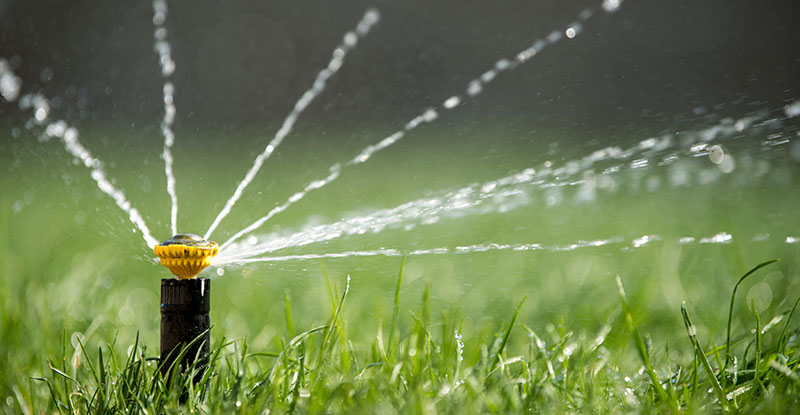
When trying to determine the best way to maximize the water you use to maintain a beautiful lawn in Southern California depends on a variety of factors, like what type of grass you have, what So Cal microclimate you live in, what time of year is it, and how you’re mowing the lawn. Given that our area has been suffering through years of especially dry winters, drought conditions and local regulations also play a role in how often you are allowed to water your lawn. Regardless of your unique situation, our staff has put together the following guidelines to help you maximize the efficiency of your lawn watering to maintain the most beautiful grass possible.
Check The Sprinklers
The first step when setting up a watering schedule is to first turn on the lawn sprinklers and check to ensure that everything is working properly and all the areas of the grass are being hit with water. Make any repairs to pipes or sprinkler heads as needed. If you’ve recently replaced your lawn, you may also need to clean some dirt or debris out of the sprinkler heads to ensure water flow from the head is optimal. We recommend checking your sprinkler system at least once a year – during the spring when new watering patters might be set.
Another option to consider is upgrading your technology. Today, homeowners have more options to consider when looking at irrigation time clocks and sprinkler heads that are specifically designed for efficiency. In fact, some of today’s systems will now automatically adjust watering schedules based on the weather. If it has been more than a few years since you’ve made any changes to your irrigation system, this might be a good time to do some research into new technology and see if an upgrade makes sense.
Determining Sprinkler Head Volume
While checking the sprinklers, it is a good idea to check the water output levels to ensure your sprinkler heads are performing as they should be. The process is pretty simple. Set out several empty cans or coffee mugs evenly throughout your lawn. Run the sprinklers for 20 minutes. Measure the water level in each container to determine an average for all containers. Most sprinkler heads are sold based on the spread of water, and not necessarily the flow. Understanding how much water your sprinkler heads put out makes calculating watering time much easier.
Calculating the Water Requirements
As a general rule, most types of grasses need 1” to 1 ½ “ of water per week. Cool season grasses tend to need a little more in the summer months and a little less in the winter months. Warm season grasses, that go dormant in the winter, need very little water during the winter. Another general rule states that it is better to water your lawn 2 to 3 times a week for longer periods of time as opposed to every day for shorter periods. This allows the root systems of your turfgrass to better absorb the water they receive without becoming over saturated. During especially hot periods, add one extra day to your weekly watering schedule.
If you’re the type of person that wants absolute precision in exactly how much water your grass needs, The University of California at Davis has developed a complete watering guide that will give you exact water needs for cool season and warm season grasses broken down by California’s climate zones. You can find this guide here: http://anrcatalog.ucanr.edu/pdf/8044.pdf
Spot Check Your Estimates
By carefully observing the lawn for a few weeks after changing a watering schedule, you will be able to see if you have adjusted your watering times correctly by the way the lawn grows. Overwatered lawns will look limp, may have pools of water several hours later and may need to be mowed much more often. Over time, an over watered lawn can lead to root rot and cause the turfgrass to yellow.
Likewise, the signs of an underwatered lawn are also pretty clear. About 12 hours after watering, if the grass seems brittle and dry, or the soil appears to have dried or cracked, you probably are not watering enough. You may see some yellow/brown patches and you may notice that when the green grass is stepped on, it doesn’t bounce back right away.
Most lawns that have been over or under watered – even for quite a long time – can recover once the watering schedule has been adjusted. If you have questions or concerns about the health of your grass and would like some personalized advice for your situation, just contact us. We’re here to help!


